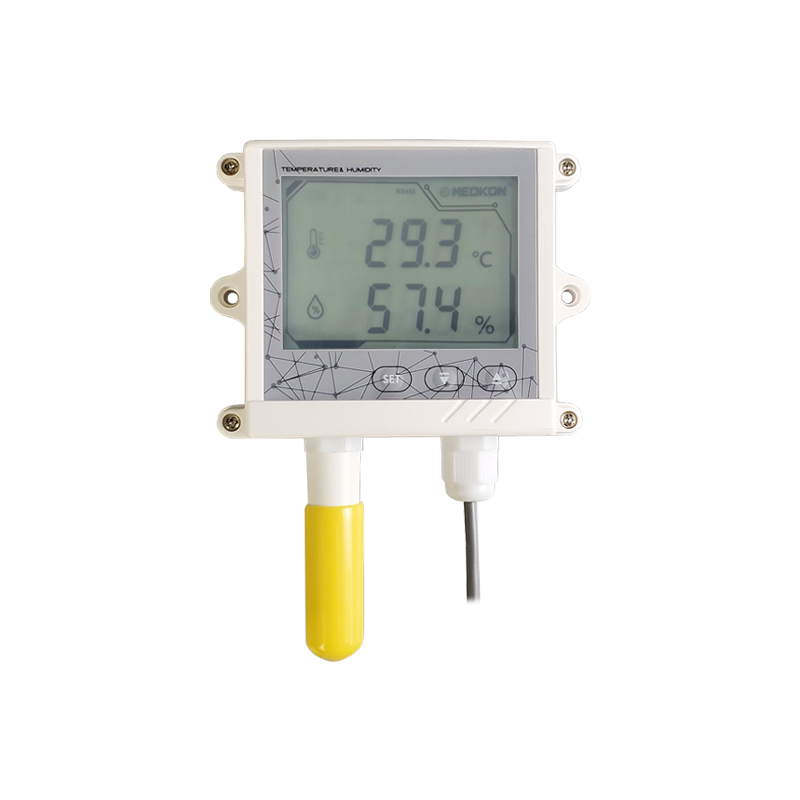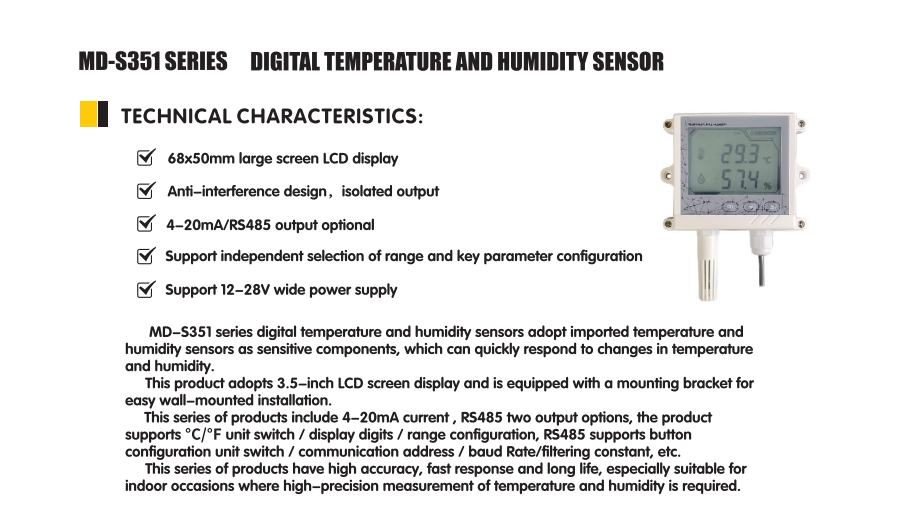The Spring Equinox, as the fourth solar term of the year, is of great significance. After the vernal equinox, most parts of Our country have entered the bright spring. At this time, the climate becomes mild, abundant rain and sunny, and most of the overwintering plants have entered the spring growth stage. A year’s plan in spring, spring greenhouse vegetable management is particularly important. As we know, temperature and humidity is an important indicator to measure the greenhouse, and the biggest obstacle to the occurrence of plant diseases in most of the sheds is caused by temperature and humidity out of control. In order to ensure the healthy growth of various vegetables in the shed, it is necessary to strengthen the temperature and humidity regulation in the greenhouse. The temperature and humidity sensor is an electronic instrument that detects and transmits the temperature and humidity in the shed. It is also a kind of sensor with the widest application scope in smart agriculture at present, including air temperature and humidity sensor and soil temperature and humidity sensor in agricultural greenhouses. The air temperature and humidity sensor is used to detect the temperature and humidity of the air in the agricultural environment, usually installed in the shade of the greenhouse air circulation. The soil temperature and humidity sensor is installed in the root soil of crops, and the depth of soil buried by the sensor is determined according to the different root depth of crops during installation, which can be used to detect the soil temperature, water content and changes in the process of crop growth and development, so as to facilitate timely and suitable irrigation. Here are two kinds of temperature and humidity sensors. Air temperature and humidity sensor The use of temperature and humidity sensor in the greenhouse can promote the growth of plants, using temperature and humidity sensor to measure and control, can effectively prevent drought, flood. And we can also know the temperature and humidity of the environment it needs by understanding the crops. When the temperature and humidity data exceeds the standard, the temperature and humidity sensor sends out signals and linkage heating/dehumidification equipment, effectively control the humidity and temperature in the shed, so that the normal growth and development of crops. For how to accurately grasp the change data of air temperature and humidity in the greenhouse, the digital display temperature and humidity sensor includes imported temperature and humidity sensor as a sensitive component, which can quickly respond to the change of temperature and humidity. The product selects 3.5-inch LCD screen display, equipped with mounting bracket, easy to adopt wall mounting. The series of products include 4-20mA current and RS485 output. The products support CF unit switch/display bit/range configuration. The digital temperature and humidity sensor output from RS485 supports button configuration such as unit switch, communication address, baud rate, and filter constant. This series of products with high precision, quick response, long life, especially suitable for indoor temperature and humidity have high precision measurement occasions. Realize the temperature and humidity change data in the shed at any time and anywhere to ensure a good environment for the growth of crops. Soil temperature and humidity sensor based on the soil temperature and humidity to determine whether plants lack of water, if it is found that lack of irrigation water should be in a timely manner intelligence, crops to meet crop demand for water, when the temperature and humidity feel enough moisture in soil will give a signal to stop water irrigation system, so as to realize the automation of irrigation system. Meet crop needs without wasting water resources. In order to collect soil temperature and humidity, the policy of promoting water-saving irrigation was carried out. The soil temperature and humidity sensor is suitable for the measurement of soil temperature and moisture. Compared with the high-precision sensor and the actual soil drying and weighing method, the sensor has high precision, fast response and stable output. Less affected by soil salt content, suitable for all kinds of soil. Can be long-term buried in the soil, long-term electrolytic resistance, corrosion resistance, vacuum sealing, completely waterproof. The sensor is widely used in scientific experiments, water-saving irrigation, greenhouse, flowers and vegetables, grassland and pasture, soil speed measurement, plant culture, sewage treatment, food storage and various particulate water content and temperature measurement. In recent years, with the increase of attention to the agricultural environment, a variety of temperature and humidity sensors have emerged. The initial temperature detection equipment is just a simple barometer. With the development of Internet of Things technology, temperature and humidity monitoring equipment is not only linked with humidifier, but also developed to be linked with intelligent air conditioning, dehumidifier and other equipment to achieve intelligent control, which greatly facilitates people’s life.
The Spring Equinox, as the fourth solar term of the year, is of great significance. After the vernal equinox, most parts of Our country have entered the bright spring. At this time, the climate becomes mild, abundant rain and sunny, and most of the overwintering plants have entered the spring growth stage.
A year’s plan in spring, spring greenhouse vegetable management is particularly important. As we know, temperature and humidity is an important indicator to measure the greenhouse, and the biggest obstacle to the occurrence of plant diseases in most of the sheds is caused by temperature and humidity out of control. In order to ensure the healthy growth of various vegetables in the shed, it is necessary to strengthen the temperature and humidity regulation in the greenhouse.
The temperature and humidity sensor is an electronic instrument that detects and transmits the temperature and humidity in the shed. It is also a kind of sensor with the widest application scope in smart agriculture at present, including air temperature and humidity sensor and soil temperature and humidity sensor in agricultural greenhouses. The air temperature and humidity sensor is used to detect the temperature and humidity of the air in the agricultural environment, usually installed in the shade of the greenhouse air circulation. The soil temperature and humidity sensor is installed in the root soil of crops, and the depth of soil buried by the sensor is determined according to the different root depth of crops during installation, which can be used to detect the soil temperature, water content and changes in the process of crop growth and development, so as to facilitate timely and suitable irrigation. Here are two kinds of temperature and humidity sensors.
A year’s plan in spring, spring greenhouse vegetable management is particularly important. As we know, temperature and humidity is an important indicator to measure the greenhouse, and the biggest obstacle to the occurrence of plant diseases in most of the sheds is caused by temperature and humidity out of control. In order to ensure the healthy growth of various vegetables in the shed, it is necessary to strengthen the temperature and humidity regulation in the greenhouse.
The temperature and humidity sensor is an electronic instrument that detects and transmits the temperature and humidity in the shed. It is also a kind of sensor with the widest application scope in smart agriculture at present, including air temperature and humidity sensor and soil temperature and humidity sensor in agricultural greenhouses. The air temperature and humidity sensor is used to detect the temperature and humidity of the air in the agricultural environment, usually installed in the shade of the greenhouse air circulation. The soil temperature and humidity sensor is installed in the root soil of crops, and the depth of soil buried by the sensor is determined according to the different root depth of crops during installation, which can be used to detect the soil temperature, water content and changes in the process of crop growth and development, so as to facilitate timely and suitable irrigation. Here are two kinds of temperature and humidity sensors.
Air temperature and humidity sensor
The use of temperature and humidity sensor in the greenhouse can promote the growth of plants, using temperature and humidity sensor to measure and control, can effectively prevent the occurrence of drought, flood. And we can also know the temperature and humidity of the environment it needs by understanding the crops.
When the temperature and humidity data exceeds the standard, the temperature and humidity sensor sends out signals and linkage heating/dehumidification equipment, effectively control the humidity and temperature in the shed, so that the normal growth and development of crops.
The use of temperature and humidity sensor in the greenhouse can promote the growth of plants, using temperature and humidity sensor to measure and control, can effectively prevent the occurrence of drought, flood. And we can also know the temperature and humidity of the environment it needs by understanding the crops.
When the temperature and humidity data exceeds the standard, the temperature and humidity sensor sends out signals and linkage heating/dehumidification equipment, effectively control the humidity and temperature in the shed, so that the normal growth and development of crops.

The digital display temperature and humidity sensor includes imported temperature and humidity sensor as a sensitive element, which can quickly respond to the change of temperature and humidity. The product selects 3.5-inch LCD screen display, equipped with mounting bracket, easy to adopt wall mounting.
The series of products include 4-20mA current and RS485 output. The products support CF unit switch/display bit/range configuration. The digital temperature and humidity sensor output from RS485 supports button configuration such as unit switch, communication address, baud rate, and filter constant.
This series of products with high precision, quick response, long life, especially suitable for indoor temperature and humidity have high precision measurement occasions
In recent years, with the increase of attention to the agricultural environment, a variety of temperature and humidity sensors have emerged. The initial temperature detection equipment is just a simple barometer. With the development of Internet of Things technology, temperature and humidity monitoring equipment is not only linked with humidifier, but also developed to be linked with intelligent air conditioning, dehumidifier and other equipment to achieve intelligent control, which greatly facilitates people’s life.
Post time: Jul-08-2022

